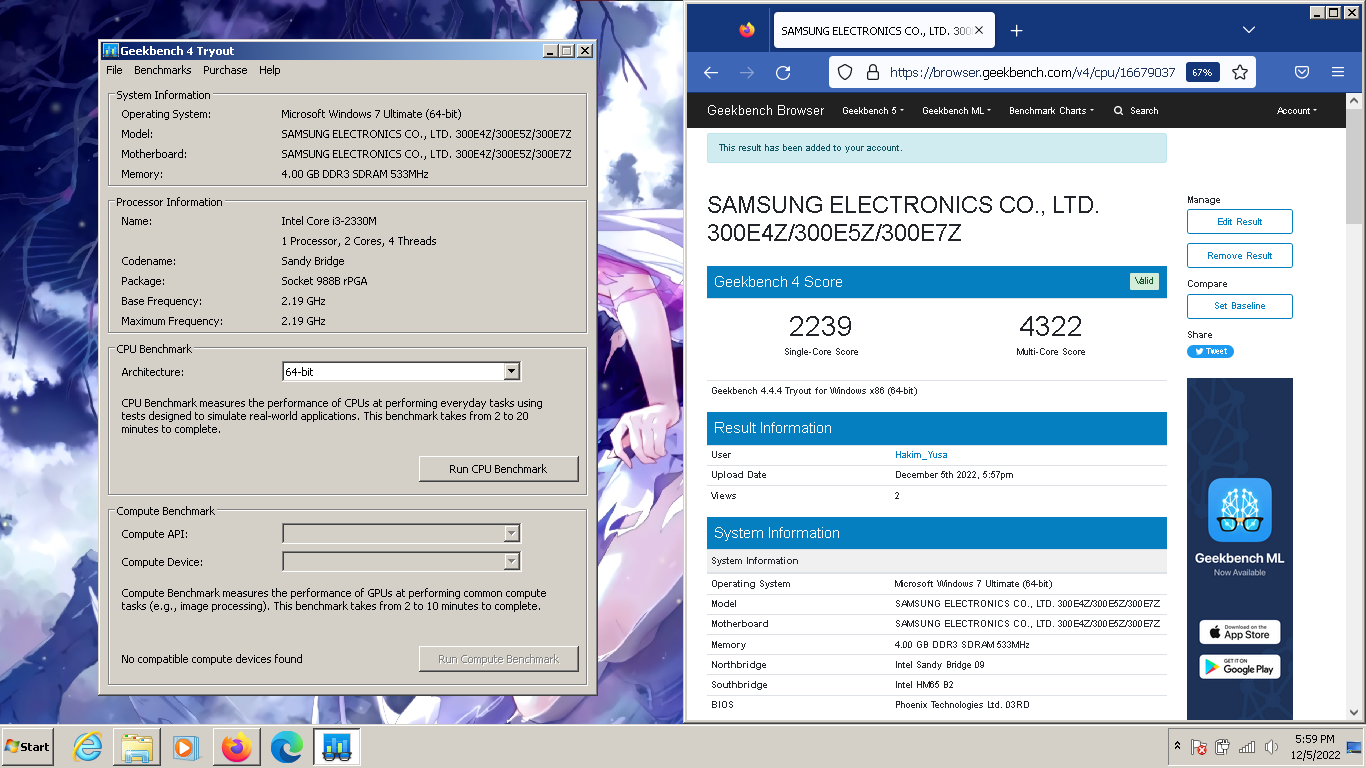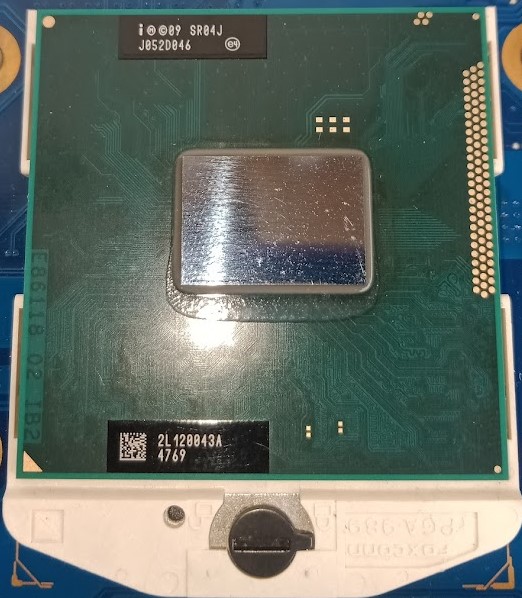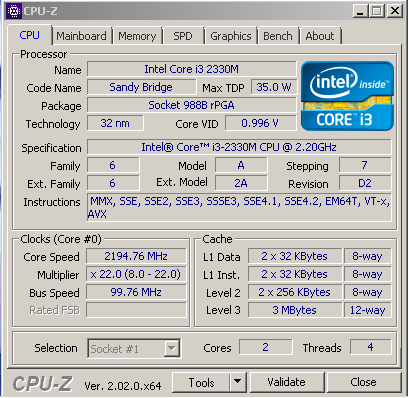Geekbench4 - Single Core score 2239 points with a i3-2330M
Thursday, 01 January 1970 07:00 | Update at null
Media Gallery
Screenshot

Device, Setup, etc



URL
https://hwbot.org/submission/5138304-
Information Detail
Hardware: Intel Core i3 2330M
Specs:CPUID : Intel(R) Core(TM) i3-2330M CPU @ 2.20GHz
Architecture : x86
Codename : Sandy Bridge
L3 Cache : 3MB
Clock : 2.20GHz
Core/Thread : 2/4
TDP : 35W
Technology : 32nm
Socket : PPGA988
IGPU : Intel HD Graphics 3000 Mobile
See more specification...
Software: Geekbench4 - Single Core
Score: 2239 points
About: Geekbench4 - Single CoreGeekbench 4 – Single Core is one of the benchmark tests designed by Primate Labs to measure processor performance in a single-core CPU workload scenario. In the world of computing, single-core performance remains an important metric because many everyday applications, including games, browsers, and other lightweight applications, still heavily rely on the speed of a single core to efficiently execute instructions.
In this test, Geekbench 4 runs a series of workload simulations that mimic real-world tasks, such as encryption, data compression, image rendering, text processing, and physics simulation—all using only one core of the tested processor. The goal is to evaluate how quickly and efficiently the CPU completes tasks individually without the assistance of additional cores, so the results reflect the processor architecture's core capabilities.
The scores obtained from Geekbench 4 Single Core are crucial for comparing performance between processors, particularly in terms of architectural efficiency and operating frequency. CPUs with high single-core scores provide a more responsive experience in light use and light multitasking. This is an important indicator when selecting a processor for general needs such as browsing, working with documents, or running business applications.
One of Geekbench 4's key advantages is its ability to run on various operating systems, including Windows, macOS, Linux, Android, and iOS. This makes Geekbench one of the most flexible benchmarking tools for fairly comparing performance across platforms and devices.
Overall, Geekbench 4 – Single Core is a highly useful tool for anyone looking to accurately assess the single-core capabilities of a processor, especially in the context of daily use that doesn’t always involve all available cores.
The Intel Core i3-2330M is a dual-core mobile processor launched in 2011 as part of Intel’s second-generation Sandy Bridge lineup. Designed for mid-range laptops, this processor features 2 cores and 4 threads thanks to Intel Hyper-Threading Technology, allowing it to handle light to moderate multitasking workloads efficiently. Operating at a fixed clock speed of 2.2 GHz and built on the 32nm process, the i3-2330M does not include Intel Turbo Boost, which limits its ability to dynamically increase performance under heavier loads, but it remains a solid choice for everyday use.
With a TDP of 35W, the i3-2330M balances power consumption and performance reasonably well for its era. It integrates Intel HD Graphics 3000, a GPU with a base clock of 650 MHz and a dynamic frequency up to 1.1 GHz. While not designed for modern gaming or demanding graphic applications, this integrated GPU handles HD video playback, basic 3D rendering, and older or lightweight games at low settings with relative ease. Users looking for casual computing and multimedia playback will find it sufficient.
In real-world usage, the Core i3-2330M performs well for standard computing tasks such as web browsing, streaming, office productivity (e.g., Word, Excel), and simple photo editing. Its Hyper-Threading capabilities give it a performance edge over older dual-core processors that lack thread duplication. However, the lack of Turbo Boost and a relatively low base frequency mean that it can struggle under CPU-intensive workloads like video rendering or large spreadsheet processing, especially when compared to more modern CPUs.
This specific configuration was tested on a SAMSUNG 300E4Z, a laptop originally shipped with an Intel Celeron B815 processor but later upgraded to the i3-2330M for better performance. With 4GB of DDR3 dual-channel memory and Windows 7 installed, the system runs smoothly for basic daily use, making the i3-2330M a practical upgrade option for budget-conscious users seeking improved performance without replacing their entire system.
Hardware Detail:
Device: SAMSUNG 300E4Z (This device originally used Celeron B815 which was upgraded to i3 2330M.)
RAM: 4GB DDR3 Dual Channel
OS: Windows 7
* Not Avaiable
